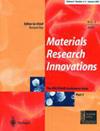多功能纳米二硫化钼(MoS2)的合成、结构特点及应用前景综述
Q2 Engineering
引用次数: 4
摘要
摘要:二硫化钼(MoS2)是一种多用途的无机材料,具有独特的电子、电学、光学和生物特性,因此在各种工程应用中得到了广泛的研究。本文的主要目的是为有意开展二硫化钼研究的研究人员提供有关二硫化钼的全面信息。综述的开始重点介绍了各种二硫化钼纳米结构的合成方法、前体和条件,如纳米球、纳米管、纳米片、纳米带、纳米花、纳米纤维、纳米团簇、纳米片和纳米线。利用各研究组报道的XRD、拉曼光谱、PL和紫外可见光谱,详细讨论了纯二硫化钼和其他复合形式的二硫化钼的结构特征。此外,通过选取扫描电镜和透射电镜图像,讨论了纯二硫化钼和复合二硫化钼的详细形态特征。最后,综述了MoS2及其复合材料在润滑剂中的多功能应用,探索了其摩擦学性能,在锂离子电池中的应用,揭示了其电学和电子性能,作为水裂解析氢反应,析氧反应的催化剂,认可了其潜在的电化学性能,各种生物医学应用,如生物传感器,生物成像,在环境应用方面也非常重要。图形摘要:MoS2应用示意图图形摘要经[1][2]、[3]许可转载,图形摘要经[1][2]、[3]许可转载。本文章由计算机程序翻译,如有差异,请以英文原文为准。
A multifunctional nanostructured molybdenum disulphide (MoS2): an overview on synthesis, structural features, and potential applications
ABSTRACT Molybdenum disulphide (MoS2) is a versatile inorganic material due to its unique electronic, electrical, optical, and biological properties, hence widely studied for various engineering applications. The main objective of this review is to provide comprehensive information about MoS2 for the researcher intended to start research on MoS2. The beginning of the review is focused on providing information on the methods, precursors, and conditions used for the synthesis of various MoS2 nanostructures such as nanospheres, nanotubes, nanoflakes, nanobelts, nanoflowers, nanofibers, nanoclusters, nanosheets, and nanowires. The structural features of MoS2, both in pure and with other composite forms, are discussed in detail using the XRD, Raman, PL and UV–visible spectra reported by various research groups. Further, the detailed morphological features of both pure and composite forms of MoS2 are also discussed by taking selected works of SEM and TEM images. Finally and very importantly, the review also summarises the multifunctional applications of the versatile MoS2 and its composites in lubricants, exploring its tribological properties, in lithium-ion batteries, revealing its electrical and electronic property, as a catalyst for water splitting hydrogen evolution reaction, oxygen evolution reactions, endorsing its potential electrochemical property, various biomedical applications such as bio sensors, bioimaging, and very importantly in environmental applications. Graphical Abstract: Schematic illustration of the Application of MoS2 Graphical Abstract is Reproduced with permission from [1] [2] ,[3] Graphical Abstract is Reproduced with permission from [1] [2], [3].
求助全文
通过发布文献求助,成功后即可免费获取论文全文。
去求助
来源期刊

Materials Research Innovations
工程技术-材料科学:综合
CiteScore
5.20
自引率
0.00%
发文量
38
审稿时长
2.8 months
期刊介绍:
Materials Research Innovations covers all areas of materials research with a particular interest in synthesis, processing, and properties from the nanoscale to the microscale to the bulk. Coverage includes all classes of material – ceramics, metals, and polymers; semiconductors and other functional materials; organic and inorganic materials – alone or in combination as composites. Innovation in composition and processing to impart special properties to bulk materials and coatings, and for innovative applications in technology, represents a strong focus. The journal attempts to balance enduring themes of science and engineering with the innovation provided by such areas of research activity.
 求助内容:
求助内容: 应助结果提醒方式:
应助结果提醒方式:


